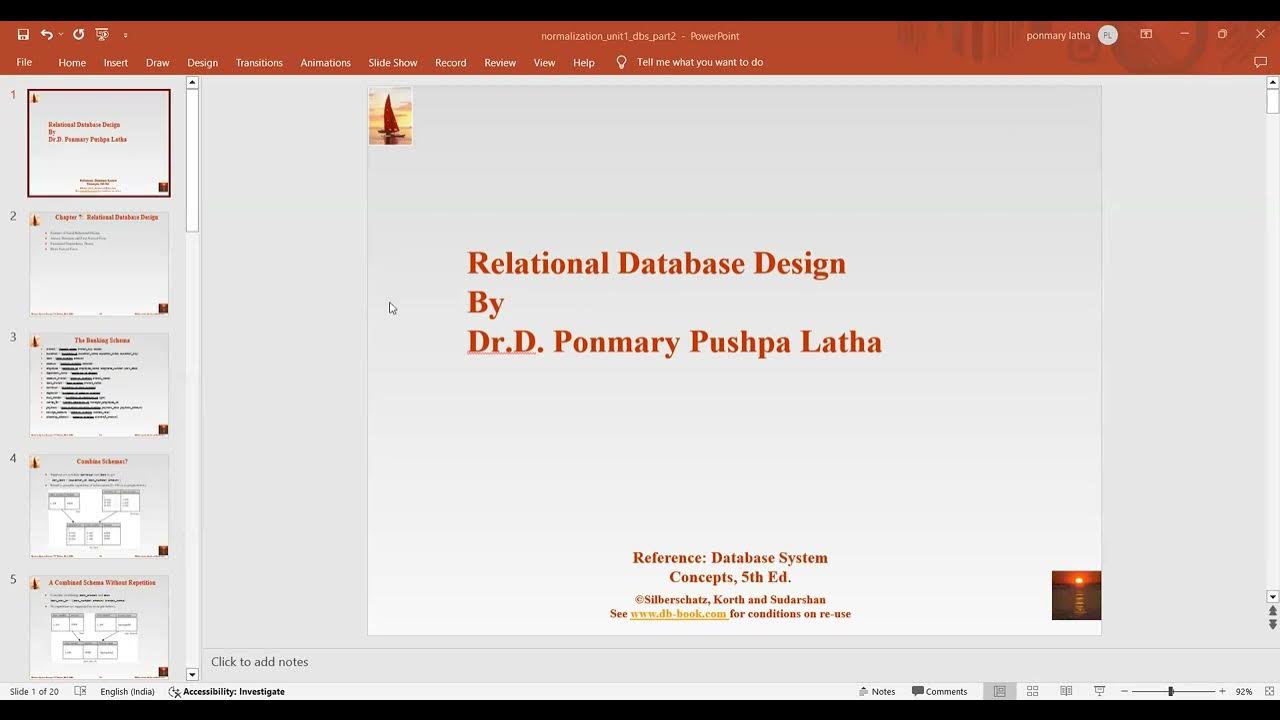Revisão Normalização de Dados
Summary
TLDRThis video script explains the process of data normalization in database design, focusing on the first three normal forms (1NF, 2NF, and 3NF). It introduces the concept of eliminating redundancy and ensuring data consistency by organizing database tables. Through a practical example of an 'Order' table, the script demonstrates how to transform a non-normalized table into 1NF, then 2NF, and finally 3NF. The goal is to create stable, scalable tables that avoid repetition and transitive dependencies, ultimately improving database performance. The video also emphasizes the importance of normalization for efficient data management and retrieval.
Takeaways
- 😀 The main purpose of normalization is to minimize data redundancy and inconsistencies in databases.
- 😀 Data normalization is a theory introduced by Edgar F. Codd in 1972, aiming to organize database tables efficiently.
- 😀 Normalization helps in reducing repeated data entries, making it easier to manage and maintain systems.
- 😀 There are three primary normal forms in data normalization: First Normal Form (1NF), Second Normal Form (2NF), and Third Normal Form (3NF).
- 😀 A table is in **1NF** when it contains only atomic (indivisible) values and does not have repeating groups of data.
- 😀 To achieve **1NF**, one must break down complex tables into smaller, related tables, ensuring each field contains a single value.
- 😀 **2NF** builds upon **1NF** and eliminates partial dependencies, meaning all non-key attributes must depend on the entire primary key, not just part of it.
- 😀 In **2NF**, data like customer information should be separated into its own table to avoid dependency on just part of the primary key.
- 😀 **3NF** eliminates transitive dependencies, ensuring that non-key attributes depend only on the primary key and not on other non-key attributes.
- 😀 By applying **3NF**, you ensure that all data is organized efficiently, reducing redundancy and improving database performance.
Q & A
What is the primary objective of data normalization?
-The primary objective of data normalization is to minimize redundancies and inconsistencies in the database, improve data manipulation, and ease the maintenance of systems.
Who is credited with the development of the data normalization theory?
-The theory of data normalization was developed by Edgar F. Codd in 1972.
What does the first normal form (1NF) require for a relation?
-The first normal form (1NF) requires that a relation should not contain any repeating groups. This means all attributes should contain atomic values, and each column should store only one value per row.
How does the normalization process help in organizing data in a database?
-Normalization helps in organizing data by eliminating redundant data, ensuring that each piece of information is stored only once, and by dividing the data into appropriate tables that minimize the risk of anomalies during updates.
What is an example of a table that is not normalized?
-An example of a non-normalized table could be a 'Pedido' (Order) table where customer information (name, address, etc.) and item details (item code, quantity, price) are all stored in a single, combined record, leading to data redundancy.
How can data be transformed into the first normal form (1NF)?
-To transform data into 1NF, you must decompose the data into separate tables, ensuring that there are no repeating groups of data, and that each field contains atomic values.
What is the second normal form (2NF) and how does it differ from 1NF?
-The second normal form (2NF) builds on 1NF and requires that all non-key attributes must depend entirely on the primary key, not just part of it. This ensures that partial dependencies are eliminated, leading to better organization of the data.
Why is the second normal form important in database normalization?
-2NF is important because it reduces redundancy by ensuring that non-key attributes are fully dependent on the primary key, thus preventing partial dependencies that can cause update anomalies.
What is the third normal form (3NF), and what additional requirement does it impose over 2NF?
-The third normal form (3NF) requires that a relation must first satisfy 2NF, and additionally, all non-key attributes must be independent of each other. This eliminates transitive dependencies, ensuring that data is fully normalized.
What is the role of the Boyce-Codd normal form (BCNF) in database normalization?
-The Boyce-Codd normal form (BCNF) is a stricter version of 3NF, where every determinant is a candidate key. It ensures that no anomalies can occur due to dependencies on non-key attributes, offering a higher level of normalization.
Outlines

Этот раздел доступен только подписчикам платных тарифов. Пожалуйста, перейдите на платный тариф для доступа.
Перейти на платный тарифMindmap

Этот раздел доступен только подписчикам платных тарифов. Пожалуйста, перейдите на платный тариф для доступа.
Перейти на платный тарифKeywords

Этот раздел доступен только подписчикам платных тарифов. Пожалуйста, перейдите на платный тариф для доступа.
Перейти на платный тарифHighlights

Этот раздел доступен только подписчикам платных тарифов. Пожалуйста, перейдите на платный тариф для доступа.
Перейти на платный тарифTranscripts

Этот раздел доступен только подписчикам платных тарифов. Пожалуйста, перейдите на платный тариф для доступа.
Перейти на платный тарифПосмотреть больше похожих видео

Normalisation Demonstration

DS-09: Normalisasi Database 1NF 2NF hingga 3NF

Basic Concept of Database Normalization - Simple Explanation for Beginners

52. OCR A Level (H446) SLR10 - 1.3 Normalisation to 3NF

Normalization in Database Management System

Types of Normalization in DBMS in Hindi|1NF | 2NF | 3NF | BCNF| 4NF | 5NF in DBMS| With Example
5.0 / 5 (0 votes)
